Painting Skirting Boards: Tips for a Neat, Professional Look
- Matej Svoboda
- Jun 12
- 3 min read
Painting skirting boards may seem like a small detail, but it’s one of the easiest ways to give your room a polished, professional finish. Whether you're painting tired wood trim or updating the look with a new colour, a clean paint job can elevate the entire space.
In this guide, we’ll walk you through the best techniques for painting skirting boards, with or without masking tape, so you get sharp lines, smooth coverage, and results that last. Perfect for DIYers and pros alike!
By following this guide, you can achieve professional-looking skirting boards without the need for masking tape. This method not only saves time but also reduces the risk of paint bleeding onto adjacent surfaces.
Why Paint Skirting Boards and Wood Trims?
Painting skirting boards and wood trim can dramatically enhance your home's appearance. Skirting boards, also known as baseboards, serve both functional and aesthetic purposes. Over time, they can become scuffed or discoloured. A fresh coat of paint not only revitalises their look but also adds a protective layer against wear and tear.
Wood trim, on the other hand, acts like the picture frame of your room. Sloppy lines, brush marks, or uneven finishes stand out—especially in bright light. On the flip side, clean, well-painted trim creates a finished look and ties the whole space together.

How To Paint Skirting Boards Without Masking: Step-by-Step Guide
Step 1: Prepare the Area
Clear the workspace: Move furniture away from walls.
Protect the floor: Lay down drop cloths or dust sheets along the base of the walls.
Step 2: Clean the Skirting Boards
Remove dirt and grease: Use a solution of mild detergent and water to wipe down the boards.
Dry thoroughly: Ensure no moisture remains before proceeding.
Step 3: Sand the Surface
Smooth the surface: Lightly sand the skirting boards with 80 to 120 grit sandpaper to remove gloss and create a surface the paint can adhere to.
Clean up dust: Wipe away sanding residue with a damp cloth.
Step 4: Repair Imperfections
Fill holes and dents: Apply wood filler to any imperfections. Once dry, sand smooth.
Seal gaps: Use caulk to fill any gaps between the skirting board and the wall. Allow it to dry completely.
Step 5: Apply Primer
Prime bare or stained wood: Use a suitable primer to ensure paint adhesion and prevent stains from bleeding through.
Let it dry: Follow the manufacturer's instructions for drying times.
Step 6: Painting Without Masking
Use a painter's shield: Hold a painter's shield or a piece of thin cardboard against the wall just above the skirting board.
Paint with precision: Using the angled sash brush, apply paint along the top edge of the skirting board, moving the shield as you progress.
Long, smooth strokes: Paint in the direction of the wood grain to achieve a uniform finish.
Step 7: Apply Additional Coats
Assess coverage: Once the first coat is dry, determine if a second coat is necessary.
Repeat the process: Apply additional coats as needed, ensuring each layer dries thoroughly before the next.
If all this sounds tricky and overwhelming, then leave it to the pros! Adam Painters and Decorators are experts in projects like these and they can get the work done in no time. You can also get an estimate for your project with their instant online calculator. Get in touch to know more about Adam’s services.

Bonus Tips for a Pro Finish
Are you after a top quality finish? Make sure you follow these pro tips!
Steady hand: Practice makes perfect. Take your time to ensure clean lines.
Go for quality paint and materials: A cheap paint will never look smooth, no matter how well you prep. So, make sure to invest in good brushes and paint for the best results.
Ventilation: Ensure the room is well-ventilated during painting and drying.
Semi-gloss vs. satin: Semi-gloss is more durable and easier to clean—great for high-traffic areas. Satin is slightly more subtle and modern.
Don’t rush drying: Give your coats time to cure. Touch-drying isn’t the same as fully cured.
Use painter’s tape sparingly: If you’re confident with a brush, you can skip the tape and get sharper lines. But if you do tape, remove it before the paint fully dries to avoid peeling.
Common Mistakes to Avoid
Avoiding these common mistakes can help ensure a top quality finish for your job.
Don't paint over dust or greasy surfaces.
Don't skip primer on bare or stained wood.
Don't use the wrong brush type (a square brush won’t cut corners cleanly).
Don't rush drying times between coats.
Don't ignore sanding between coats.
The Final Word
Painting wood trim and skirting boards can elevate the finish of any room. Whether it’s around doors, windows, baseboards, or crown moulding, freshly painted trim gives your home a polished, clean edge. To get a crisp, professional look, you need the right method—not just any brush and bucket of paint!



